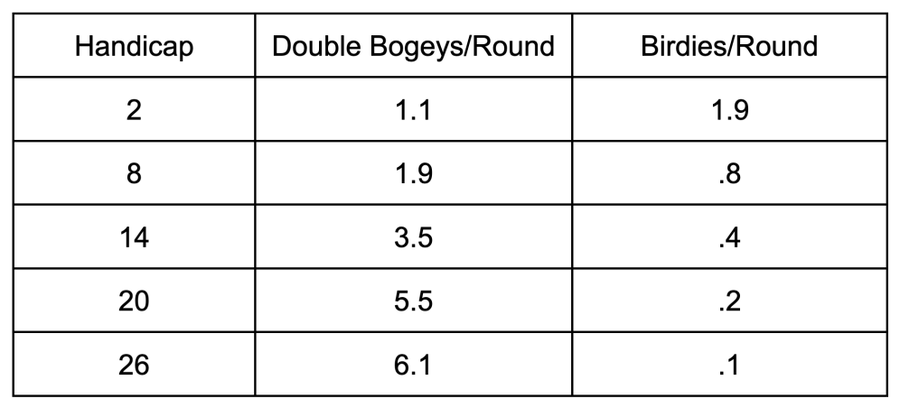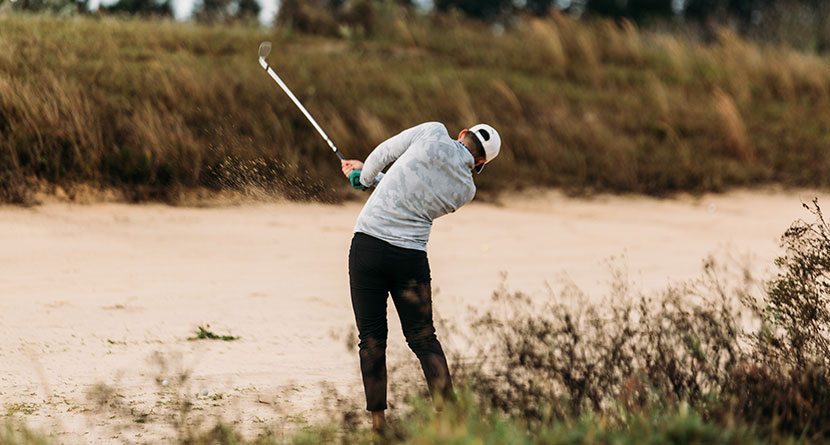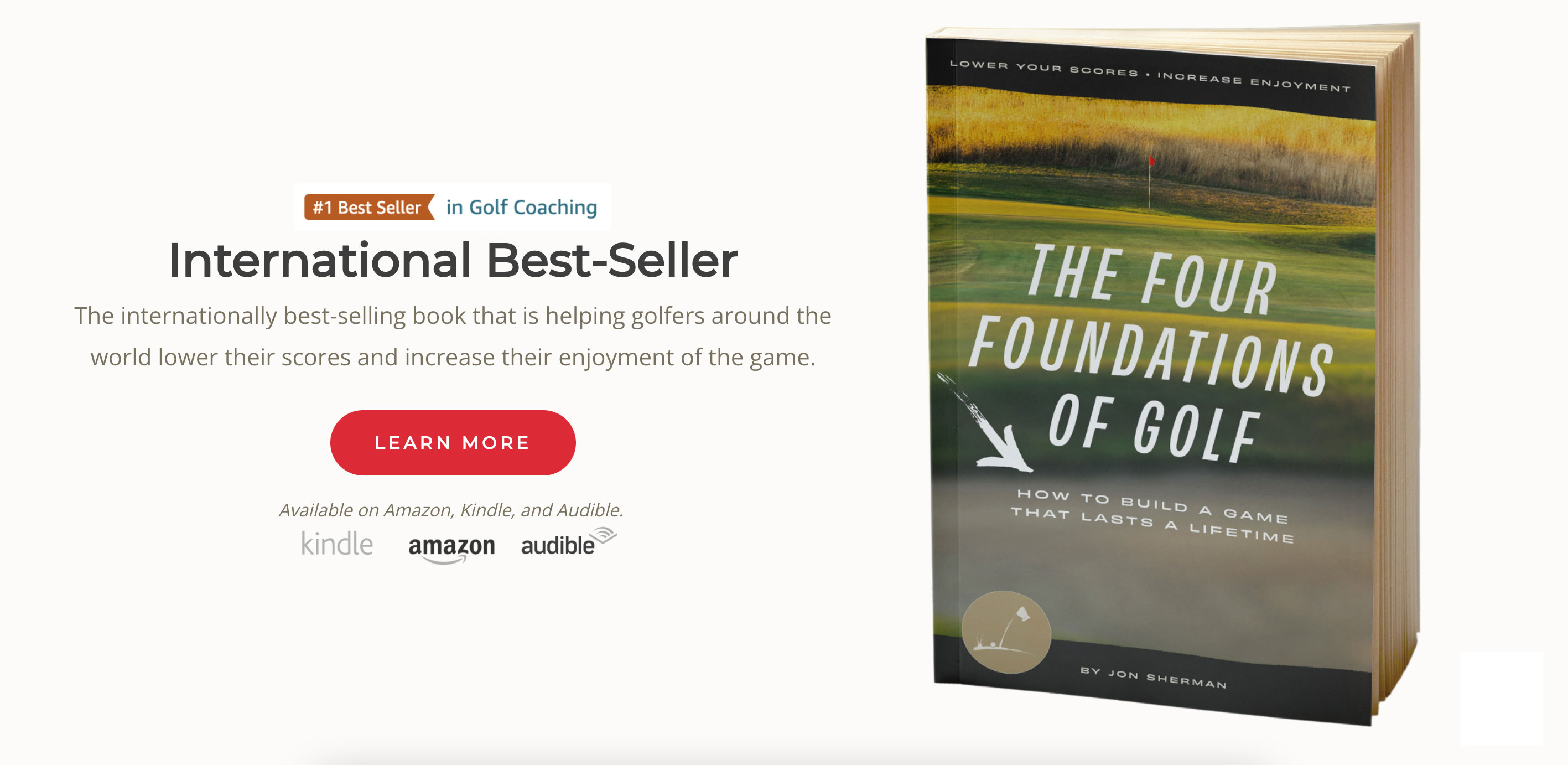The following is an excerpt from Jon Sherman’s The Four Foundations of Golf, a complete guide to golf that a player of any level can use to lower their scores and increase their enjoyment of the game.
This excerpt comes from Part Two of Jon’s Book: STRATEGY.
No matter what level of golfer you are, one of the keys to improvement is limiting double bogeys (or worse). Many players assume that it’s more about making birdies and pars because those scores are more fun. While I want to help you with those too, my focus is more on the bigger scores.
You can see which score separates the lower handicaps versus higher handicaps!

The majority of this book is about helping you limit double bogeys. This concept is so important to me that the phrase “fighting the war on double bogeys” is the official tagline of my website Practical Golf. Double bogey avoidance is crucially important when it comes to strategy.
I’d like to explore a few hypothetical situations to set the table for the rest of the course management section. Each example will contain elements I will explore in the coming chapters and how strategy can significantly impact your score.
The Sucker Pin
You have just hit an incredible drive and find yourself in the middle of the fairway with 150 yards to the center of the green. The pin is tucked in the front portion, guarded by deep bunkers. The front of the green is 137 yards, and the pin is just beyond it at 143 yards. Since you hit your 8-iron about 140-145 yards, you decide that is the right club to select. You’re thinking birdie!
You hit your 8-iron, and unfortunately, you strike it poorly, and it lands in the bunker. You don’t have a great lie, and the bunker is pitched well below the green surface; you’re a bit nervous. Sadly, you blade your ball over the green. After chipping it on the green to 15 feet, you two-putt for a double bogey.
Making a double bogey from the middle of the fairway is incredibly frustrating. Let me describe how you could have easily avoided that situation.
The center of the green was 150 yards, and the distance to the back of the green was 162 yards. That means you had almost 20 yards of room to land your ball beyond the pin. Let’s say you chose more club in this situation and still didn’t strike it that great. You easily could have kept the ball on the putting surface. At worst, you would have a relatively straightforward chip from behind the green. The likelihood of making par would have increased dramatically, and your worst expected outcome would likely have been a bogey. You could have reduced your score by 1-2 strokes by just taking an extra club.
The Hero Shot
You have hit your drive into a cluster of trees. When you arrive at your ball, you are still angry about your mistake and aren’t thinking so clearly. There is a small opening in the trees, and you desperately want to make par. The green is only 130 yards away, and you figure it is not that hard of a shot.
You decide to go for it and hit a punch shot with your 5-iron with the hope of running the ball onto the green. You quickly find out that trees are, in fact, not 90% air. Your ball ends up in a worse position than where you started.
It ends up being a triple bogey, ouch.
Let’s say you had decided to take the easier path, and pitch your ball back into the fairway to leave yourself with a 60-100 yard wedge shot. Your chances of landing the ball on the green from that distance are relatively high, and your expected outcome would likely be a bogey or double bogey at worse. Even if you made the double, you still save yourself a shot in this instance.
Mickelson-ed
Your approach shot misses the green, and you’ve got one of those “in-between” lies in the rough where almost anything can happen. You have short-sided yourself, and there isn’t much room between the green and the pin. That doesn’t stop you from opening up your lob wedge and trying to pull off a Phil Mickelson flop. Your club slides beneath the ball, and it lands about 3 feet in front of you, leaving yourself almost the same exact shot. You take your medicine and chip your next shot 15-20 feet beyond the hole and two-putt for a bogey.
Had you played the high-percentage shot the first time, there would be another stroke that was easily saved.
Where Golfers Are Separated
I have watched enough golfers at varying levels to understand what separates those that reach their scoring goals and those that do not. Believe it or not, avoiding double bogeys by making smarter decisions is one of the main separating factors.
While increasing your skill and technique is part of limiting disaster holes, you must meet two general goals with course management:
- Knowing what smart play is based on your skill level and the situation.
- Having the presence of mind to make the right decision.
In the coming chapters, I’ll help clarify how to identify what smart choices are. Overall, I want all of your mindsets to be focused on doing everything you can to avoid double bogeys. This is the not-so-secret to becoming a better golfer.
The Big Ideas
- At every handicap level, double-bogey avoidance is a more significant separator in scoring potential than birdies.
- One of the cornerstones of course management is making optimal decisions that will reduce double bogeys.
- Aggressive decision-making, particularly on approach shots and greenside wedges, is counterproductive. Often, it results in an increase in score rather than the desired outcome (birdie).





